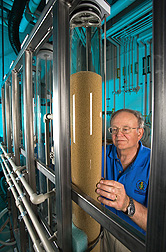This page has been archived and is being provided for reference purposes only. The page is no longer being updated, and therefore, links on the page may be invalid.
Read the magazine story to find out more. |
|
|
Corn Protein Polymers Inspire Diverse New Uses
By Jan SuszkiwNovember 20, 2008
Zein, a major corn protein, is primarily used in specialty coatings, such as for paper. Now, improved methods of purifying and modifying zein devised by Agricultural Research Service (ARS) scientists could usher in new cosmetic and biomedical applications as well.
Zein has been commercially available for more than 60 years. But costly purification steps necessary to eliminate zein's odor and yellow color have hampered its widespread commercial use. Chemist David Sessa examined the problem in studies at the ARS National Center for Agricultural Utilization Research in Peoria, Ill.
Based on his findings, which included isolating the primary sources of zein's color and odor, Sessa devised an improved approach to purifying the protein and turning it into two types of polymers: hydrogels and microspheres.
Existing methods of purifying zein use activated carbons (AC), which are porous, charcoal-like substances that bind to and trap the compounds responsible for the protein's color and odor. However, these AC-based methods lose between 37 and 95 percent of the zein in the process of purifying it. This increases production costs and restricts zein's broader commercial use.
Sessa's ground-up approach included examining AC alternatives known as "zeolites," silicate- or clay-based particles whose pores act as molecular sieves in which zein's color and odor compounds are trapped during purification. His use of two synthetic zeolites, dubbed types "A" and "X," increased zein yields by 25 percent during purification.
Two other key innovations included an ultraviolet-light-based method to monitor zein's deodorization progress, and an algorithm-controlled system to control zein's directional flow inside specialized columns where purification occurs.
Sessa envisions several cosmetic and biomedical applications for zein-based microspheres and hydrogels, including dissolvable drug capsules and tissue scaffolding. On the food front, zein has potential as a chewing gum ingredient.
Read more about this research in the November/December 2008 issue of Agricultural Research magazine.
ARS is a scientific research agency of the U.S. Department of Agriculture.


